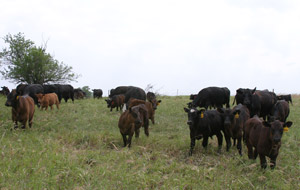Methane emissions from manure
Part 1: What is manure?
May 2014
 Beef cattle excrete nutrients such as organic matter, nitrogen, and minerals in urine and feces. Excretion is based on diet digestibility, intake amounts, and production stage or size of cattle.
Beef cattle excrete nutrients such as organic matter, nitrogen, and minerals in urine and feces. Excretion is based on diet digestibility, intake amounts, and production stage or size of cattle.
Methane (CH4) is a carbon compound which originates from microbial fermentation of organic matter, under anaerobic (lack of oxygen) conditions. While much of the focus on methane production by cattle is on enteric fermentation losses in the rumen, some methane may be produced from manure naturally, as well as purposely in anaerobic manure digesters. One of the biggest factors impacting natural production of methane from manure is the system used for housing cattle, as the housing system will have dramatic impacts on manure conditions (anaerobic or aerobic) and methane production from manure.
Manure is a quite vague term and can refer to numerous situations and contain various mixes of urine, feces, soil, and/or bedding. Manure can be different ages of manure that have undergone aerobic decomposition or anaerobic fermentation as most pens are cleaning semi-annually.
In grazing situations, manure is deposited as urine and feces in sporadic areas and separate from one another. Very little research has been done on methane emissions from fecal deposition in pasture situations.
In confinement systems where manure is collected and maintained in semi-liquid states, manure then would be a purer mixture of feces and urine excreted by cattle and will be more anaerobic. In some housing systems such as mono-slope barns, bedding can be added which makes manure a mixture of feces, urine, and bedding. In confinement systems where manure is allowed to dry such as deep-bedded barns, manure is handled as a solid.
In open, outdoor lots common to feedlots, manure is a mixture of feces, urine, and soil that is unavoidably mixed together by cattle and removed during cleaning. Bedding can also be added to open lots, but depends on climate. Significant variation exists within pens due to cattle defecating and urinating patterns, mounds, pen slope, and pen designs, and moisture collection during precipitation. In addition, another area where a small portion of nutrients are collected in open lots for beef cattle are runoff retention ponds. These ponds collect all precipitative runoff from feedlots larger than 1,000 head capacity; however, less than 5% of the nutrients (N, P, OM) are collected in retention ponds.
Each of these housing systems can lead to emissions as methane is produced when organic matter (OM) is fermented by bacterial growth under anaerobic conditions.
Galen Erickson
Professor
Animal Science
University of Nebraska–Lincoln
References
Clark, R. N., A. D. Schneider, and B. A. Stewart. 1975. Analysis of runoff from southern great plains feedlots. Trans. ASAE 18(2):319-322.
Eghball, B., and J. F. Power. 1994. Beef cattle feedlot manure management. J. Soil Water Cons. 49:113-122.